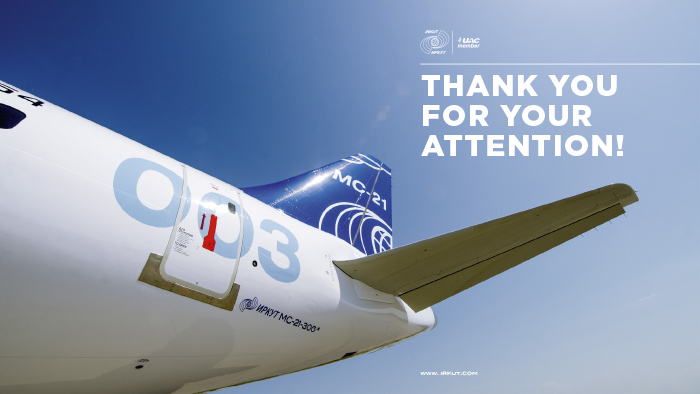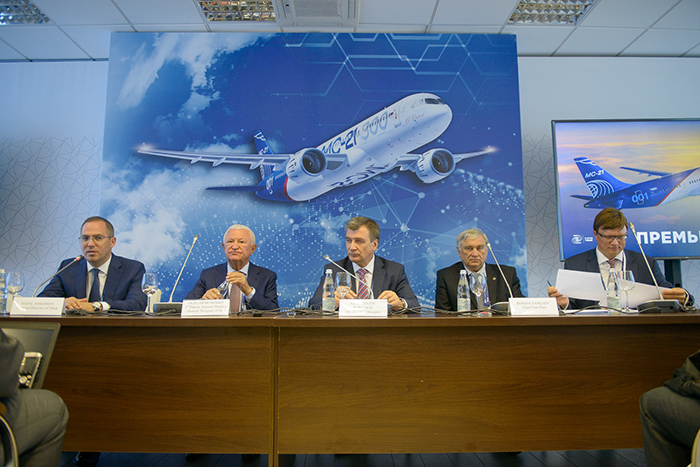
The event was attended by the General Director of Irkut Corporation PJSC - Ravil Khakimov, First Deputy General Director - General Designer of Irkut Corporation PJSC, General Director - General Designer of OKB A.S. Yakovleva Oleg Demchenko, Deputy General Director of PJSC Irkut Corporation for the Development of Aviation Engineering Director of the Engineering Center, Chief Designer of the MC-21 Konstantin Popovich. Vice President of Marketing and Sales of Irkut Corporation PJSC Kirill Budaev, Senior Test Pilot Roman Taskaev.
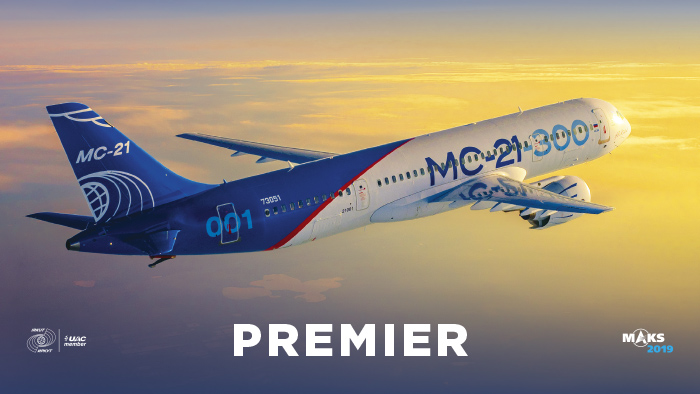
PJSC Irkut Corporation acts as the lead contractor for the MC-21-300 project within the United Aircraft Corporation (UAC), which designs, tests and builds this short-haul passenger aircraft. The basis of the Corporation’s design potential is the Engineering Centre named after A.S. Yakovleva, specialising in the development of passenger and combat training aircraft.
Kirill Budaev, Vice President, Marketing and Sales, Irkut Corporation
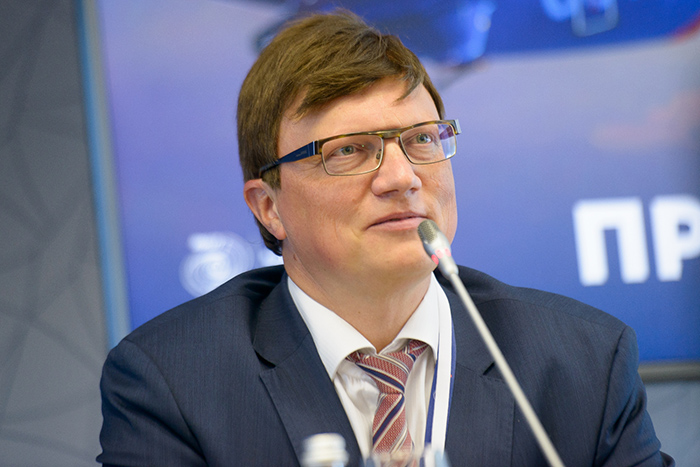
The main production site of the Corporation is the Irkutsk Aviation Plant, a branch of PJSC Irkut Corporation. Over the past few years, the enterprise has undergone technical re-equipment, introduced digital technologies, and deployed modern automated lines for aggregate and final assembly. Most of these works were carried out in preparation for the deployment of mass production of the MC-21-300 aircraft. As a result of the reconstruction, the plant became one of the most modern and high-performance enterprises in the Russian aircraft manufacturing industry.
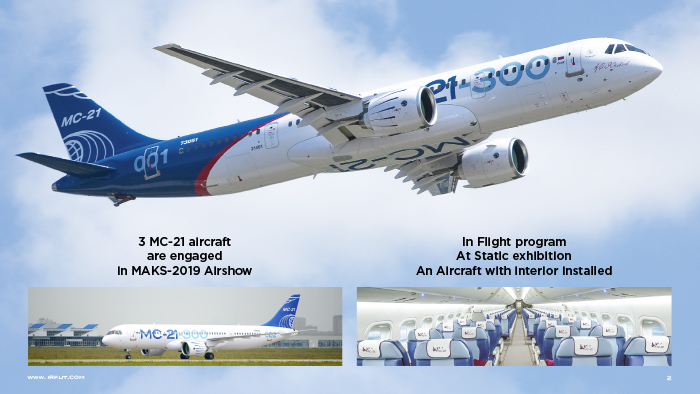
At the MAKS-2019 airshow, we demonstrate the MC-21-300 aircraft, with a capacity of up to 211 passenger seats. The plane is in the most sought after niche. We analysed a lot of orders that are placed on competitors' planes, they all show that planes of increasing capacity are being ordered. Demand balances between the A320 and A321. It is in this segment that the MC-21-300 is located.
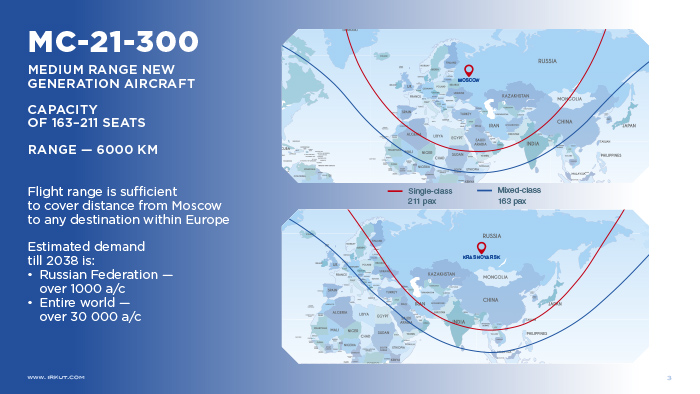
The flight range of the MC-21-300 is 6,000 km. This allows you to fully cover the demand of Russian airlines for medium-haul traffic. According to our forecast, over the next 20 years, about 30,000 such aircraft in the world will be required, and about 1000 aircraft will be a potential demand for the MC-21 aircraft. Frankly, this is a conservative view, I, as a seller, hope that this figure doubles and triples, but my plans will be adjusted by life itself, of course, because 20 years is a long period of time.
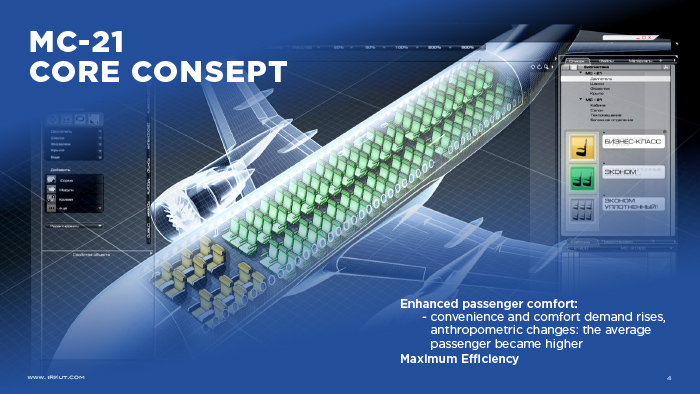
The MC-21 aircraft is based on two criteria - economic efficiency and comfort. From the very beginning, we have very tightly consulted with airlines. We have had a series of advisory tips involving airlines from all over the world - Southeast Asia, Western Europe, Russia, the CIS, Latin America, that is, all of our target markets. And these two key drivers were highlighted by interested potential buyers.
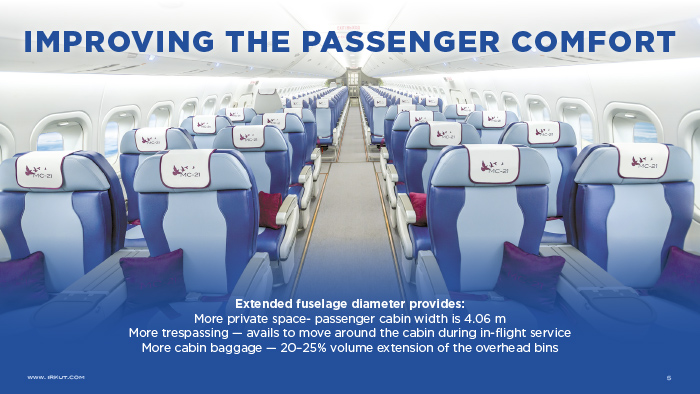
MC-21 is the most wide-body narrow-body aircraft. It was decided to expand the width of the fuselage, which gave a lot of great opportunities, especially for passengers. Its width is 4m 6cm, which is about 31cm wider than the Boeing 737. The width of the cabin allowed to increase efficiency, because there is a great demand for low-cost transportation, for reducing turnaround time. The wide fuselage makes it possible to make a wide aisle, which saves about 7 minutes on every turn flight. This gives 175 hours of extra flight per year. This is not an unfounded figure, because at the design stage, we conducted field tests - invited volunteers and pretended to complete unloading and loading of the aircraft. These 7 minutes were calculated empirically. The plane is made for the passenger. Many are already tired of the tight layout of low-cost carriers. And even low-cost airlines are now thinking about increasing personal space and even introducing a business class. We solved this problem in a constructive way, leaving the opportunity for airlines to experiment inside the passenger compartment.
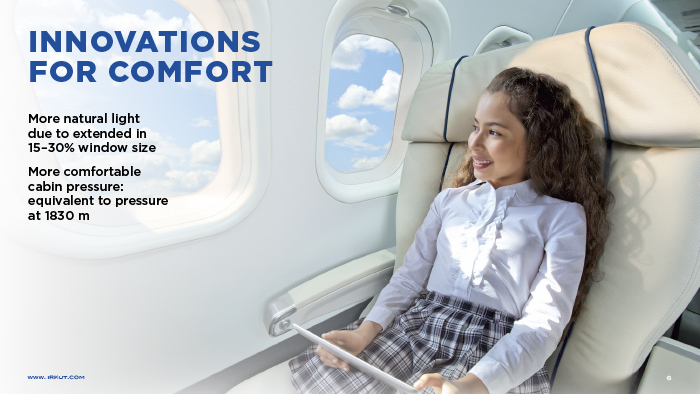
Since 10% of all passengers have hidden or open aerophobia, the natural light with which our cabin is filled, thanks to the very wide portholes, reduces the negative impact of enclosed space on a person. Plus there are special design solutions that open the space for a passenger sitting by the window. When you go into the salon, you will feel a completely different sensation - there is no pipe effect, a very large space is opened to the eye. There is a feeling that you are sitting in a wide-body aircraft. In addition, the pressure in the passenger cabin is increased on the plane, usually it is equivalent to 8 thousand feet, for us - 6 thousand. The passenger feels less tired and healthier on board the plane. After the flight, you don’t get tired, the reason for this is high blood pressure. This is especially noticeable on long flights - if you spend 5 hours at an altitude of 8 thousand feet (2400 meters), fatigue makes itself felt both among passengers and the crew. Increased pressure is not only comfort, but also increased safety for controlling the aircraft.
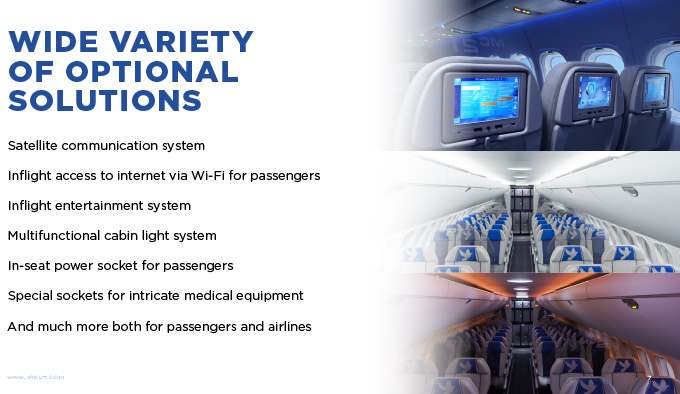
Since flying is always romance and pleasure, the aircraft will be equipped with both an entertainment system and a satellite communications system. There is a special multi-colour passenger compartment lighting system with millions of colours to create the right mood on board the aircraft. Of course, sockets for feeding smartphones, wifi distribution and other services. In short, the aircraft will be very modern.
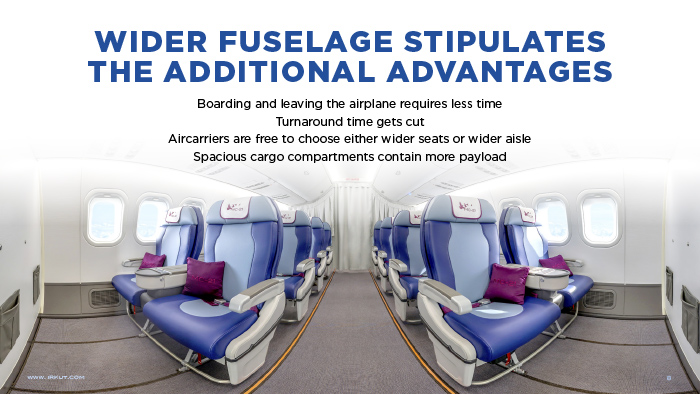
On the slide, you see a business class cabin on an MC-21 aircraft. A very wide fuselage provides plenty of space and light, wide seats and an aisle. At the request of the airline, it will be possible to set the layout of the seats in business class even 2 + 3 in a row, which will create additional passenger capacity.
Konstantin Fedorovich Popovich - chief designer of MC-21
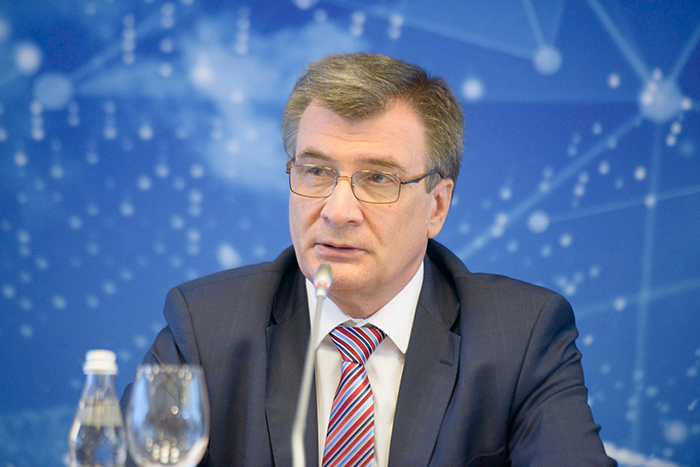
We set ourselves the task of increasing the operational capabilities of the aircraft and its efficiency in the region of 8-10% of the existing fleet of aircraft of this class, which are now operating in the world. This problem could be solved only in the following way: increasing efficiency, increasing the quality of the wing and reducing aerodynamic drag. To get a wing and an airplane with minimal resistance and maximum quality, a wing of large elongation is necessary. A wing of large elongation is naturally necessary to make from non-traditional materials - this is a composite. Therefore, a composite is not our desire or fashion, but a specific target for achieving high efficiency of our aircraft.
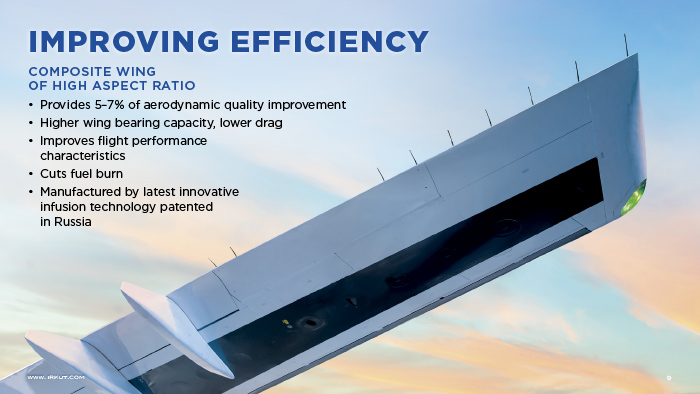
The wing provides us with good performance and is manufactured using innovative infusion technology without the use of an autoclave. Infusion technology is patented in Russia, we have developed a technology for manufacturing large-sized aggregates from composite materials.
The second component is the power plant. The use of engines at the moment is Pratt & Whitney PW1400G. In the future, we will consider issues related to another engine - PD-14, so that we can offer companies the choice of power plant and options that we offer. These engines provide high efficiency. As a result, we reduce fuel consumption for the passenger seat and reduce overall costs.
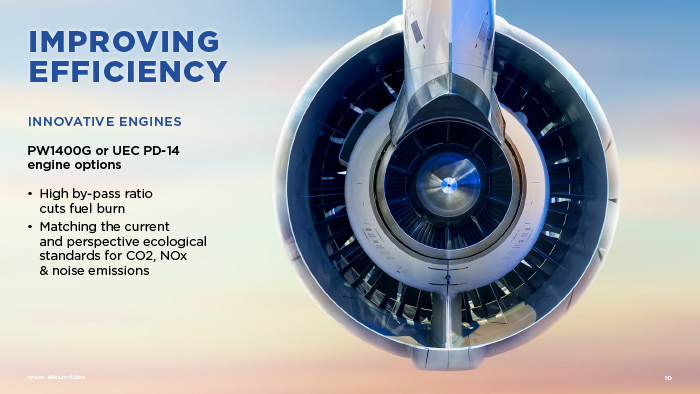
A high bypass ratio is not only a reduction in fuel consumption, but also a better use of energy, that is, combustion of fuel in the engine. The new engines meet promising environmental requirements for CO2 emissions and noise. All this leads to the fact that this aircraft meets the latest requirements and even new amendments to be adopted in 2020, regarding noise and emissions. We think that in the future, in this regard, it will sell well, in terms of meeting the requirements. Noise reduction is noticeable even when taxiing the plane to the strip. When tested, even nearby people noted an extremely low noise level. Based on the test results, we confirm that we comply with the noise requirements of both engines and the aircraft as a whole.
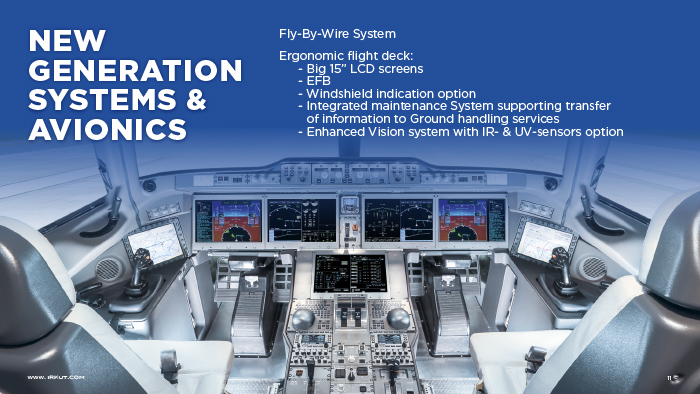
To achieve the objectives, in addition to the wing and the engine, the aircraft naturally uses a digital system, an integrated and remote control system. It provides not only good control quality, but also damping of additional loads, increasing the resource, to solve the problems and requirements that are presented to the aircraft. The cabin is equipped with 15-inch monitors, electronic tablets - carriers of documentation. Equipment is optionally provided for ensuring landing according to category 3A - these are indicators on the windshield. This, respectively, is an improved vision system that includes infrared and ultraviolet sensors. And all this is combined into an on-board integrated control system with transmission to the ground services and the technical crew after the flight, information about the state of the aircraft on the ground and recommendations for troubleshooting, if necessary.
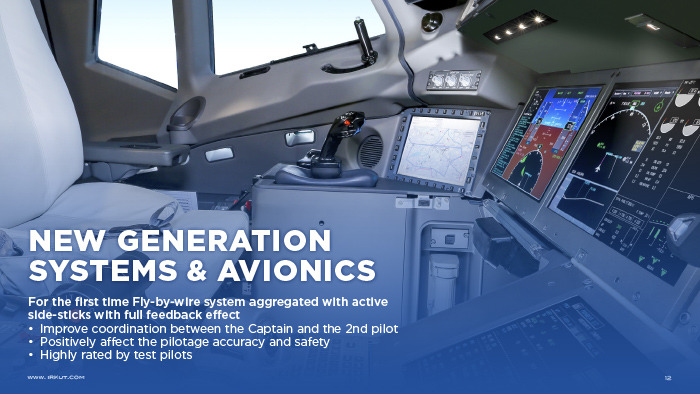
An exceptional feature of the control system and the cab is the active control handle. Currently, passive handles are used on planes of this class in world practice - each pilot controls the handle and transfers the right to control the shift. Our handles are electronically integrated, and, with the help of micro-motors, provide the transfer of forces and movements, as if they are connected by a single whole mechanism. In addition, additional functions are implemented - the transfer of tactile information. When reaching the limit modes, approaching dangerous modes, the pen also transmits tactile information to the pilot. EASA representatives flew on the plane, performed about 14 control flights to complete stall modes, to achieve large angles and to operate the control system.
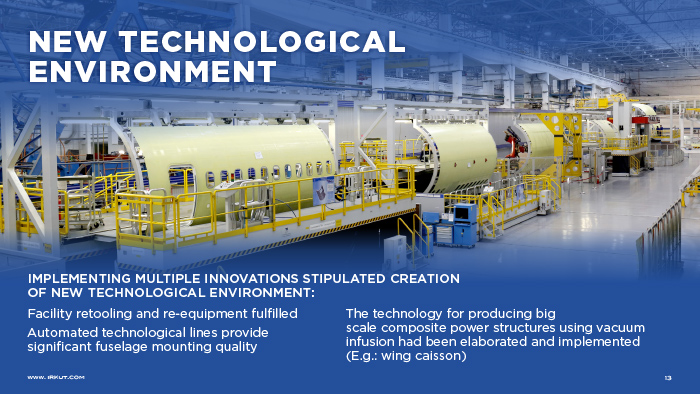
You noticed that all three prototypes of the aircraft are made using technology close to serial and have very good quality manufacturing of the fuselage, wing and controls. This is what was laid at the very beginning in the design of the airframe and in the technology of its manufacture. The technology was based on the manufacture of large composite and non-composite panel fuselage with subsequent assembly at the factory. Therefore, the surface quality of the panels of even the first experimental aircraft riveted on automatic equipment is very impressive.
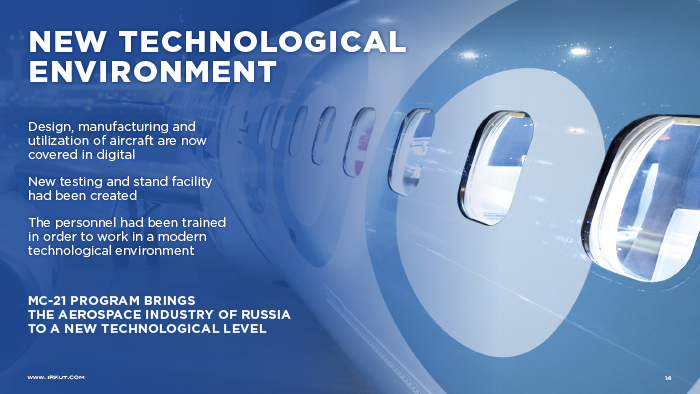
In order to accomplish this task, a technical re-equipment of the enterprise was carried out, equipping them with assemblies, riveting machines and other automated tools that allow us to fulfil the tasks that we face. Most of all, this concerns the manufacture and molding of composite structures. A rather complicated wing shape, and here a wing of large elongation with a super critical profile was chosen, it requires rather accurate manufacturing and design of equipment. We were forced to conduct a comprehensive implementation of digital technology. This also applies to the design bureau of the developer and the plant, and the enterprises involved in the cooperation. Trained specialists who are able to work in this technological environment. Here in Zhukovsky and the Irkutsk Aviation Plant, new test equipment was created. These are automated stands and other testing equipment, including telemetry, that we use for testing.
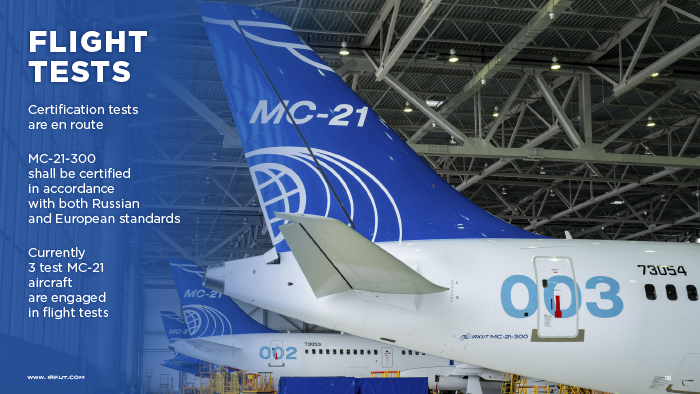
In terms of flight testing, we are now in the middle of certification testing. We performed bench tests, static tests, as well as tests of airframe units, which allowed us to completely remove operational restrictions on the aircraft.
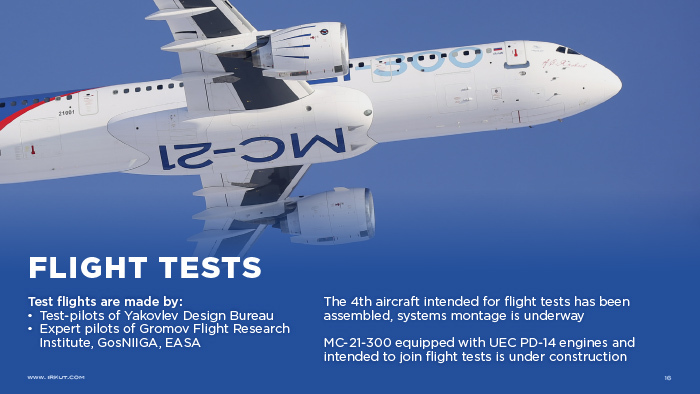
All three flight models of the aircraft participate in the tests. The third one is specifically designed for the tests that we need to conduct on the cabin and air conditioning systems. The fourth aircraft has been assembled; systems are being installed. By the end of the year, we hope to lift it into the air. The 5th aircraft is also being built, which will be put into testing with the PD-14 engine next year.
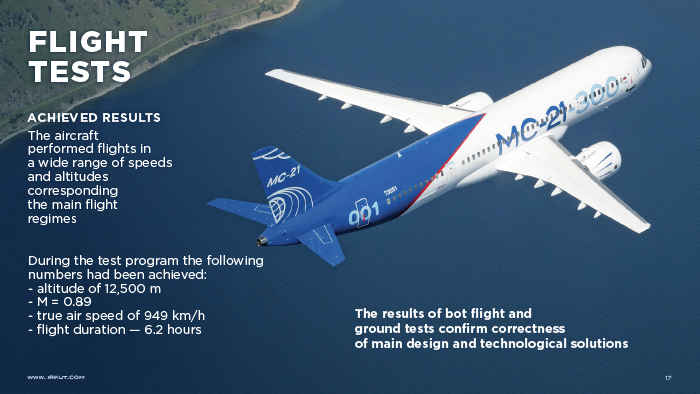
The confirmation of the achievement of key characteristics is that we have almost completed the main tests to determine the operability of systems, to confirm the main characteristics, including the operability of engines and their starting in air in all modes. And their performance when performing any modes that have operational limitations. Interesting flights were performed with minimum speeds achieved, with a heel touching during take-offs.
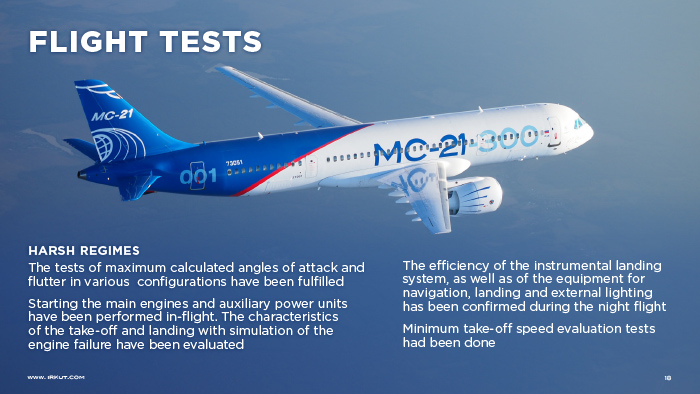
At the moment, all the basic parameters that we laid on the plane are practically achieved - this is a height of 12.5 km, the MAX speed is greater than we laid, and also confirmed the stiffness of the wing and flutter characteristics.
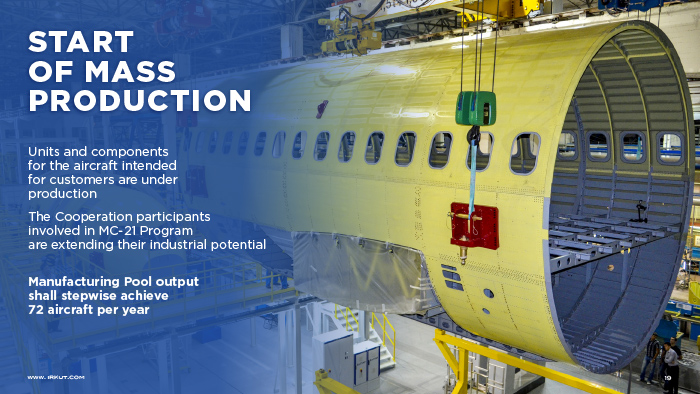
As for the mass production, production and launch of parts for the series aircraft, we are currently underway, without waiting for the completion of certification tests. We are confident that our technical solutions and the standard design that we have identified at the moment will be practically unchanged in the mass production of aircraft. The productivity of cooperation will be phased to the level of 72 aircraft per year. This is an ambitious target that we will achieve in 6 years.
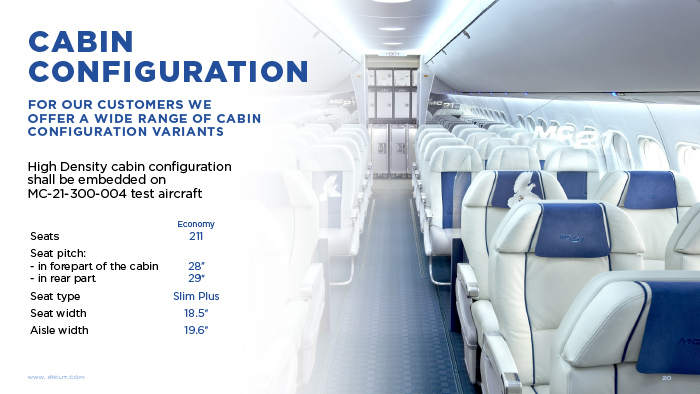
The design uses new materials, both metallic and composite, with a reduction in the complexity of manufacturing and increasing the life of the aircraft. Naturally, in order to improve operation, the number of components with a limited resource is reduced. According to the documentation, we took into account the accumulated experience of the SSJ100 project and the requirements of the airlines that work with us. At the moment, the basic set of operational documentation has been developed and is being updated according to test results. It is issued in the form of interactive electronic technical manuals, which meets modern international requirements.
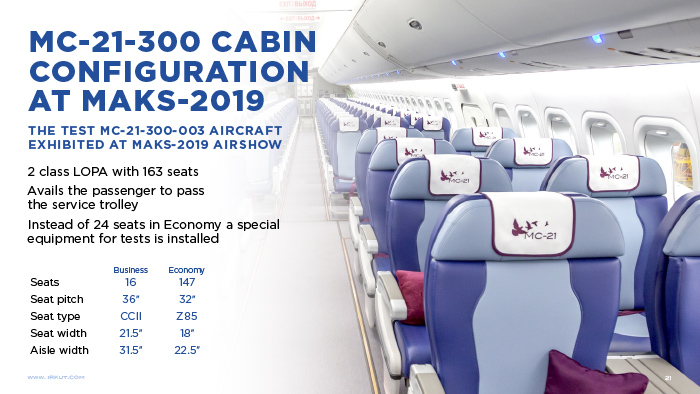
A web portal is also being developed to host up-to-date documentation and software for exchanging information on aircraft operation, including online. This is more about providing after-sales service. We have developed technical training aids, created a comprehensive full-flight simulator, a procedural simulator. Well, of course, the line of simulators for emergency rescue procedures for the cabin crew and a set of training computer classes. This kit is located at the Aeroflot Training Centre, our first customer. A list of spare parts has been compiled. An order has been formed for the production of spare parts to provide operators. We hope to provide this 2 months after the first deliveries of the aircraft. These are the tasks that need to be solved for the future operation of the aircraft, and we are solving these tasks.
